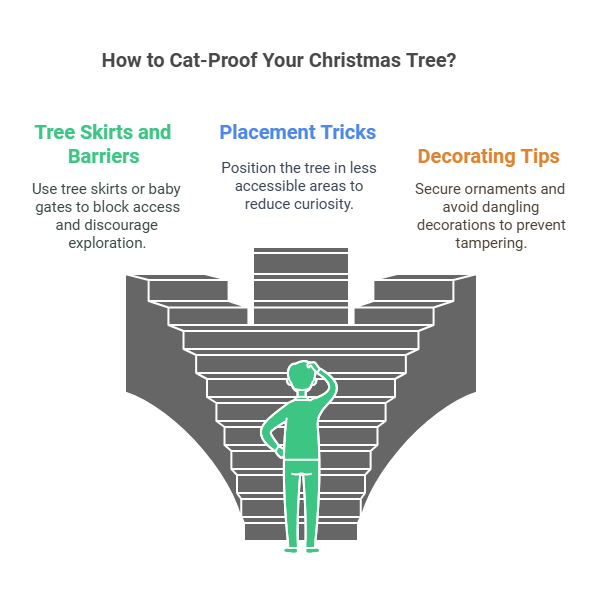Do you dread the moment your cat sees the Christmas tree? Cats seem to think these festive centerpieces are giant playgrounds. But this fun can quickly turn hazardous. From chewing on branches to attacking ornaments, cat chewing Christmas tree is not just annoying—it’s potentially dangerous. Let’s explore why this happens and how to save your tree (and your sanity) this holiday season.
Why Do Cats Chew on Christmas Trees?
Cats have their quirks, but their fascination with Christmas trees comes down to instinct and curiosity:
- Natural Curiosity: Cats are drawn to anything new in their environment. A towering tree with dangling ornaments? That’s irresistible.
- Teething and Chewing: Younger cats may chew because they’re teething. Older cats might just enjoy the texture of those branches.
- Scent and Sound Appeal: Pine needles give off a fresh smell, and shiny ornaments make intriguing noises.
- Playful Instincts: Ornaments are essentially dangling toys for cats. Can you blame them?
| Reason | Explanation |
|---|---|
| Natural Curiosity | Cats explore new items in their environment. |
| Teething and Chewing | Younger cats may chew due to teething issues. |
| Scent and Sound Appeal | Pine smell and shiny ornaments attract them. |
| Playful Instincts | Ornaments resemble dangling toys. |
You May Like to Read:
The Dangers of Cats Chewing Christmas Trees
A chewing cat isn’t just a holiday headache; it can lead to serious issues:
- Health Hazards: Chewing on pine needles (real or fake) can cause stomach upset or even punctures in the digestive tract. Ingesting tinsel or hooks? A choking nightmare.
- Electrocution Risks: Christmas lights are tempting for cats to gnaw on. One bite can lead to a shocking outcome.
- Tree Damage: A toppled tree or broken ornaments could ruin your holiday vibe.
Preventive Measures to Keep Cats Away from Christmas Trees
Protecting your tree (and your cat) requires a mix of creativity and strategy. After all, your festive centerpiece deserves to shine without feline interference, and your cat’s safety is paramount.

By understanding their natural curiosity and planning accordingly, you can enjoy the holidays without constant battles over the tree. Here’s how:
Choosing the Right Tree
Opt for a fake Christmas tree with sturdy branches. Are fake Christmas trees safe for cats? Generally, they’re safer than real ones because they lack sharp pine needles, but they still require precautions to ensure safety. Loose plastic needles or small detachable parts can pose choking hazards, so inspect the tree carefully before decorating.
Avoid flocked or snow-covered trees, as the chemicals used in these coatings can be harmful if ingested by curious pets.
Secure the Tree
- Anchor your tree to the wall or ceiling using fishing line or sturdy wire. A wobbling tree is a cat’s dream.
- Use a heavy tree base to prevent tipping, especially if your cat is prone to jumping or climbing. A solid, weighted base ensures stability, reducing the chances of your tree toppling over. For extra safety, consider a wide-bottomed base that distributes weight evenly. This not only protects your cat from potential injury but also spares your ornaments and lights from a disastrous fall.
Use Cat Deterrents
- Try a cat deterrent spray for Christmas tree areas. Citrus-based sprays work well, as cats hate the smell.
- Sprinkle cinnamon or citrus peels around the base. Your cat’s nose will do the rest.
Limit Temptations
- Keep fragile ornaments high and out of reach.
- Avoid tinsel, which is basically cat candy but incredibly dangerous.
- Hide or cover electrical cords with cord protectors.
How to Cat-Proof Your Christmas Tree
If your cat views your tree as a personal jungle gym, it’s time to outsmart them:

- Tree Skirts and Barriers: Use a tree skirt or baby gate to block access to the lower branches. A tree skirt not only adds a festive touch but also acts as a subtle barrier, discouraging your cat from exploring the tree’s base. For extra protection, a baby gate can create a physical boundary that’s harder for your curious kitty to bypass. If you’re feeling creative, you can even build a decorative fence around the tree for a stylish yet functional solution. Remember, keeping the lower branches out of reach significantly reduces your cat’s temptation to chew or climb.
- Placement Tricks: Place your tree in a less accessible corner or on an elevated platform. Cats love to explore, so positioning the tree in a spot that’s hard for them to reach, like a room with a closed door or a corner away from their favorite climbing spots, can reduce their curiosity. If you have a smaller tree, consider setting it on a sturdy table or platform—just ensure it’s stable to avoid toppling accidents. Creating a designated “no-tree zone” makes it easier to discourage your cat from investigating the tree entirely.
- Decorating Tips: Secure ornaments with twist ties instead of hooks. Ditch dangling decorations altogether.
Humor break: Ever tried reasoning with a cat? Good luck! Cat-proofing your tree might be easier than convincing them otherwise.
Video Credit: The Purring Journal
Keep Your Cat Distracted
A bored cat is a mischievous cat. Distract them from the tree with these ideas:
- Alternative Chew Toys: Provide plenty of safe chewable toys, like catnip sticks or soft rubber toys.
- Cat Tree or Play Area: Set up a dedicated area with a cat tree or scratching post nearby.
- Interactive Playtime: Tire them out with feather wands or laser pointers.
Summarize distraction techniques:
| Distraction | Description |
|---|---|
| Chew Toys | Safe options like catnip sticks. |
| Cat Tree/Play Area | Nearby tree or scratching post. |
| Interactive Playtime | Feather wands or laser pointers to tire them. |
What to Do If Your Cat Chews the Tree Anyway
Even the best-laid plans can fail. If your cat gets to the tree:
- Immediate Actions: Remove any chewed parts from their mouth. Check for signs of ingestion or injury.
- Monitor for Symptoms: If your cat shows signs of vomiting, lethargy, or choking, contact your vet immediately.
- Reassess Your Setup: If your methods aren’t working, it’s time to get creative—or call in reinforcements. A vet or animal behaviorist can offer additional advice.
Are Fake Christmas Trees Safe for Cats?
Yes, but with conditions. While fake Christmas trees are generally safer than real ones, they’re not foolproof:

- Watch for Allergies: Some cats can be allergic to fake Christmas tree materials like PVC.
- Inspect for Loose Pieces: Fake needles or plastic parts can be choking hazards.
- Use Cat Deterrents: Pair your fake tree with a cat deterrent for Christmas tree success.
A comparison chart between real vs. fake trees
| Aspect | Real Tree | Fake Tree |
|---|---|---|
| Safety | Risk of sharp needles | Risk of loose plastic parts |
| Maintenance | Needs watering | Easy to clean |
| Smell Appeal for Cats | Strong pine scent | Minimal scent |
FAQs on Cats and Christmas Trees
Why does my cat chew on fake Christmas trees?
Your cat is likely attracted to the texture, scent, or movement of the branches. Fake trees can still mimic real ones in these aspects.
How do I keep my cat away from my fake Christmas tree?
Use deterrent sprays, keep toys nearby, and secure the tree with barriers or anchors.
Can cats get sick from chewing on Christmas trees?
es. Both real and fake trees can cause stomach issues or worse if ingested. Monitor your cat closely and consult a vet if you’re concerned.
What’s the best cat-proof Christmas tree?
A sturdy, artificial tree with minimal dangling decorations and a secure base is ideal.
Should I take my cat to the vet if they’ve chewed on the tree?
Yes, if you notice symptoms like vomiting, lethargy, or difficulty breathing. Better safe than sorry.
The holidays should be fun for both you and your pets. With a bit of planning, you can stop cat chewing Christmas tree disasters before they start. Whether it’s using deterrent sprays, providing distractions, or cat-proofing your tree, there are plenty of ways to keep your furry friend safe. If all else fails, don’t hesitate to seek advice from your vet. Here’s to a stress-free holiday season for you and your playful companion!










